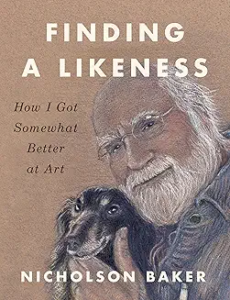Finding a Likeness: How I Got Somewhat Better at Art by Nicholson Baker 2024
I’ve read three of Baker’s previous books, loving his immersive study of John Updike and a book of his essays, but hating one of his novels. So it was with some curiosity that I checked this book out when I found it on the New Books shelves in Harvard’s undergraduate Lamont Library, a place where I had spent many hours napping during college.
Nicholson once again showed his creative spirit and multiple talents. As described on the flyleaf, this is an “unusual art book… a record of meditative, pencil-pointed self-improvement that demonstrates how rapidly a person of very average artistic talent can heal wounds of disillusionment and, by studying clouds, shadows, trees, and especially, the singularities of the human face, find answers to some of the big questions of creative life.”
At the age of 67, living in Maine, and exhausted and depressed by his last book about how the U.S. Government had conducted secret horrible programs, Baker was searching for a new purpose in life. He found it in learning to draw and paint. Diving into the internet, he discovered artists whose work he valued and whose style he tried to adopt. He also discovered Pinterest and a number of You Tube sites which demonstrated various techniques for drawing and painting. Like a kid in a candy shop, he bought lots of different materials—pencils, oil and acrylic paints, pastels, brushes and markers, different kinds of paper—and with great courage, went at it.
His book introduces the readers to his favorite artists, to various materials and techniques, but most of all to the steadily improving portraits that Baker was turning out as COVID struck and he was restricted to home. Discovering that tracing an image on his computer screen provided a great starting point, he learned to shade and even worked with loops. By the book’s end, he was turning out what appeared to this observer as professional grade work.
A good editor might have shortened the book by one-third, but clearly Baker was having such a good time that he, no doubt, would have resisted this. Bottom line is that this is a fine book for anyone who also wants to learn to draw with great references to artists, materials, and techniques.



